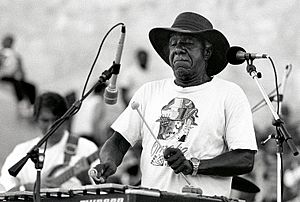Culture of North Omaha, Nebraska facts for kids

The culture of North Omaha, Nebraska is shaped by its many different people. This part of Omaha is known for its mix of backgrounds, including different income levels, races, and ethnic groups. A big part of North Omaha's culture comes from its large African American community.
Contents
Celebrating Culture in North Omaha
North Omaha hosts many important events each year. These events celebrate the community, its history, and its future.
Annual Community Events
- Native Omaha Days is a special event that happens every two years. It brings together members of Omaha's African American community. One part of this celebration is the Evergreen Reunion, named after a town in Alabama where many families' ancestors came from.
- The Juneteenth Parade celebrates the day enslaved people in Texas learned they were free, marking the end of slavery in the United States.
- The Fort Omaha Intertribal Powwow is a gathering where Native American tribes celebrate their culture with dancing, music, and traditions.
- The Omaha Blues, Jazz, & Gospel Festival showcases amazing music.
- Florence Days is a local celebration in the Florence neighborhood.
- The Omaha North High School Homecoming includes a parade for the whole community.
- The Stone Soul Picnic is another important community gathering.
Places of Culture and History
North Omaha has many places that are important for its culture and history.
Historic Meeting Places
- The Fair Deal Cafe was a very important spot for over 50 years. People called it the "Black City Hall" because it was a central place for the African American community to meet and discuss important issues.
- The John Beasley Theater is named after actor John Beasley, who grew up in Omaha. This theater helps people learn about and get involved in theater, dance, music, poetry, and writing.
Jazz and Music Heritage
North Omaha has a proud history as a major center for jazz music.
- Dreamland Plaza is next to the historic Dreamland Ballroom. From the 1920s to the 1960s, Dreamland was the best place in Omaha for jazz, blues, and big band music. Today, the plaza hosts cultural events, and there's a project to restore Dreamland and bring back North Omaha's jazz scene.
- The Love’s Jazz and Art Center works to collect, share, and preserve the history of African Americans in the arts. It's named after Preston Love, a famous Omaha jazz musician who played saxophone with Count Basie.
- Other important jazz figures from North Omaha included Lloyd Hunter, Anna Mae Winburn, and Helen Jones Woods, a trombonist with the International Sweethearts of Rhythm.
- The Omaha Black Music Hall of Fame was created in 2005 to honor this rich musical past.
Preserving Black History
- The Great Plains Black History Museum was started by Bertha Calloway in the 1960s and opened in 1976. It is the only place in Omaha dedicated to collecting and sharing African American history.
Old Movie Theaters
North Omaha once had many movie theaters.
- The Diamond Moving Picture Theater was destroyed by a tornado in 1913.
- Other theaters like the Beacon, Corby, Lothrop, Circle, North Star, and Minne Lusa Theater opened in the 1930s and 1940s. Most of these theaters closed in the 1950s.
European American Culture in North Omaha
In the late 1800s, North Omaha was home to many European immigrants.
- The area had a strong Jewish community with several synagogues that offered social and cultural activities.
- Catholic churches welcomed Irish and German immigrants.
- Near Florence, many people from Scandinavia settled. They had their own churches and social clubs, making the area a cultural hub for many working and middle-class white families.
- Over time, many industrial jobs were lost in the 1950s and 1960s. This led to changes in the neighborhood, and it became mostly African American.
African American Culture in North Omaha
North Omaha has always been a lively center for African Americans. Many came after the 1910s, and they have greatly helped shape Omaha's economy, politics, and values. Even with challenges like racial tension, many African Americans became involved in the civil rights movement to fight for equal rights.
Neighborhood Changes Over Time
In the late 1800s, the area closer to downtown North Omaha was home to many white families, including those who were wealthy or middle class, and Jewish families. Many churches, synagogues, and social clubs from that time still exist today, even as more people moved to West Omaha. For example, Calvin Memorial Presbyterian Church shows how North Omaha changed from a wealthy white area to a mostly Black inner-city neighborhood. Some churches and neighborhoods practiced racial discrimination. A 1966 film called A Time for Burning looked at efforts to end segregation in Omaha.
The history of white working, middle, and upper-class families in North Omaha can still be seen in the buildings and homes. Many neighborhoods, like Kountze Place, are known for their important architecture.
Images for kids
-
Luigi Waites playing vibraphone.


